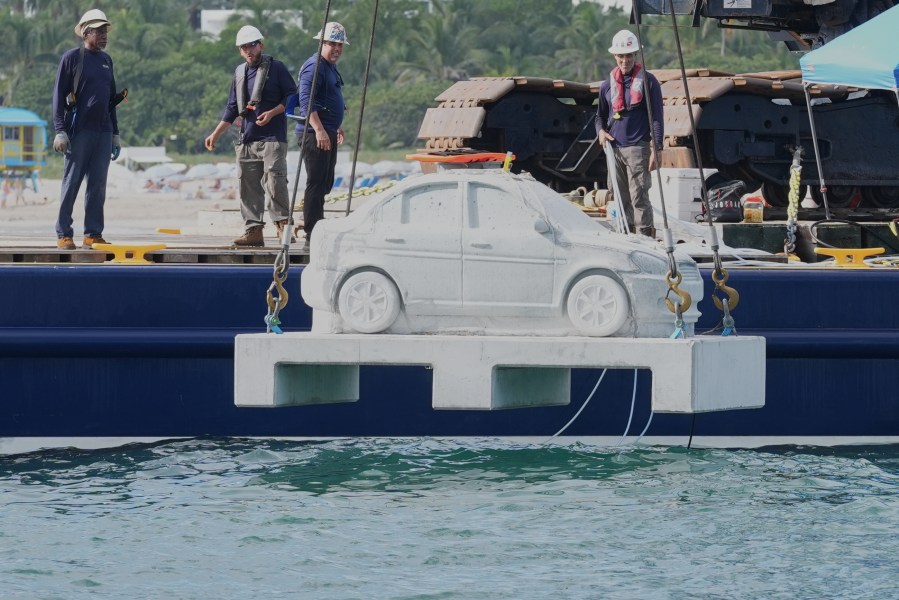MIAMI BEACH, Fla. (AP) — A wave of new cars is coming to South Florida, but they’re not adding to traffic or lengthening commute times. That’s because the car was made of marine-grade concrete and was placed underwater.
Over several days late last month, crews sank 22 full-sized cars into the ocean hundreds of feet off the coast of South Beach. The project was organized by a group that pioneered underwater sculpture parks as a way to create artificial coral reefs.
Concrete Coral, commissioned by the nonprofit organization REEFLINE, will soon be seeded with 2,200 native corals grown in a nearby Miami lab. The project is partially funded by a $5 million bond from the City of Miami Beach. The group is also trying to raise $40 million to extend the project, which could span 11 phases, along an undersea corridor just outside the city’s 7-mile-long (11-kilometer) coastline.
“I think we’re making history here,” said Ximena Caminos, the group’s founder. “This is a pioneering underwater reef that partners with science and art like no other.”
She devised the overall plan with architect Shohei Shigematsu, and artist Leandro Erlich designed the first phase car sculpture.
Colin Ford, who runs REEFLINE’s Miami Coral Research Institute, said he plans to begin planting trees soon to create a soft coral forest above the car sculpture that will serve as a habitat for marine life.
“I think it really captures the depth of the artistic message itself of cars getting stuck underwater,” Ford said. “Nature is coming back and we are helping it by growing soft corals.”
Ford said he is confident that native gorgonian corals will continue to thrive because they were grown from survivors of the 2023 bleaching event, when a marine heatwave wiped out corals in Florida.
Plans for future developments include Petroc Sesti’s “Heart of Oceanus,” modeled after the heart of a giant blue whale, and Carlos Betancourt and Alberto Latorre’s “Miami Reef Star,” a large star of starfish shapes.
“That will accelerate the formation of coral reef ecosystems,” Ford said. “This will attract more life, increase biodiversity, and really push the boundaries of artificial reef construction here in Florida.”
In addition to being a testing ground for the development of new coral transplants and hybrid reef designs, Miami Beach Mayor Stephen Miner hopes the project will create local jobs through ecotourism experiences such as snorkeling, diving, kayaking and paddleboard tours.
Coral reefs are located approximately 20 feet (6 meters) below the surface and approximately 800 feet (240 meters) from shore.
“Miami Beach is a global model for so many different issues, and now we’re doing that for REEFLINE,” Miner said at a beachside ceremony last month. “We are very proud to be working with the private market to ensure this work continues here in Miami Beach and serves as a blueprint for other cities to leverage.”
The nonprofit also offers a community education program where volunteers can plant corals alongside scientists, and a floating marine learning center where participants can experience first-hand coral conservation each month.
Caminos, the group’s founder, acknowledged that the installation would not solve all problems as big as climate change and sea level rise, but said it could start a conversation about the value of coastal ecosystems.
“We can show how creatively, collaboratively, and interdisciplinaryly we can tackle human-made problems with human-made solutions,” Kaminos said.





